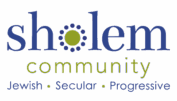Culturally Jewish. Not Religious.
Sholem School Curriculum
Putting Good Ideas into Practice
The Sholem Sunday School's excellent teachers have substantial training and experience in progressive teaching techniques that create projects, pose problems, and use engaging in-class activities that encourage student participation and group involvement. Our classes are fun, creative, connected, caring, contextualized, and rigorous in their pursuit of critical and independent thinking.
What follows is the focus of each two-year class; however, it should be noted that we teach a “spiral curriculum” in which content is returned to throughout the years. As students mature, material is re-introduced over time with increasing complexity, building on previous learning so as to deepen and broaden the students’ understanding according to their developmental stages. Further, our teachers work very closely to ensure continuity in class content, and also to help students develop their own expressive and intellectual inquiry. Each class incorporates a guiding question that ties together the content of the lessons.
Grades, Themes, and Focus Areas
Alef: Pre-K – Kindergarten — Click to View Curriculum
Marking Time Together
The Pre-K through Kindergarten class, Marking Time Together, follows a curriculum centered around the year of Jewish holidays with an emphasis on both natural and human cycles. ... The guiding question of the Marking Time Together curriculum is: “Who Are We?”
Beys: First and Second Grade — Click to View Curriculum
Many Ways of Being Jewish
The 1st-2nd grade class, Many Ways of Being Jewish, explores Jewish cultures around the world, past and present. ... The guiding question of the Many Ways of Being Jewish two-year cycle is: “How do we express who we are?”
Giml: Third and Fourth Grade — Click to View Curriculum
Beginnings
The 3rd-4th grade class, Beginnings, explores the historical and mythological origins of early humans and ancient Jewish culture ... The guiding question of the Beginnings two-year cycle is: “How did we get here?”
Daled: Fifth and Sixth Grade — Click to View Curriculum
Roots
The 5th–6th grade class, Roots, is an in-depth exploration of Jewish holidays ... The guiding question of the Roots two-year cycle is: How does what we do reflect what we believe?
Hey: Seventh and Eighth Grade — Click to View Curriculum
Who Are the Jews? The Ancients and the Moderns
The 7th-8th grade class, Who are the Jews, explores Jewish literature, art, music and political life ... The guiding question of the Who are the Jews two-year cycle is: “How do we know what we think we know?”
Vov: Ninth and Tenth Grade — Click to View Curriculum
Jews in the 20th century, today, and tomorrow
The 9th-10th grade class explores ideas from all sides ... The guiding question of the Jews in the 20th century curriculum is: “What is truth, and how do we reconcile our understanding when one person’s truth is at odds with another’s?”
Belfer: Eleventh and Twelfth Grade — Click to View Curriculum
Belfer
The eleventh and twelfth grade students participate in the community as belfer, Yiddish for “helper.” ...
Four Focus Lenses
Our entire curriculum is filtered through four “lenses,” or focus areas. Everything we design, from a two-year class, to a 45-minute lesson, is continuously filtered through these four lenses:
- Lens of History in Context: Situates major Jewish historical events in the larger world history, connects history to social action, and explores cultural development.
- Lens of Culture and Tradition: Asks what culture is worth preserving and why, includes exposure to Jewish languages and holidays.
- Lens of Diversity and Identity: Focuses on identity, personal expression, and awareness of inclusion and power dynamics.
- Lens of Values in Action: Encourages ethical inquiry, social responsibility, and personal/family values expression in action.
